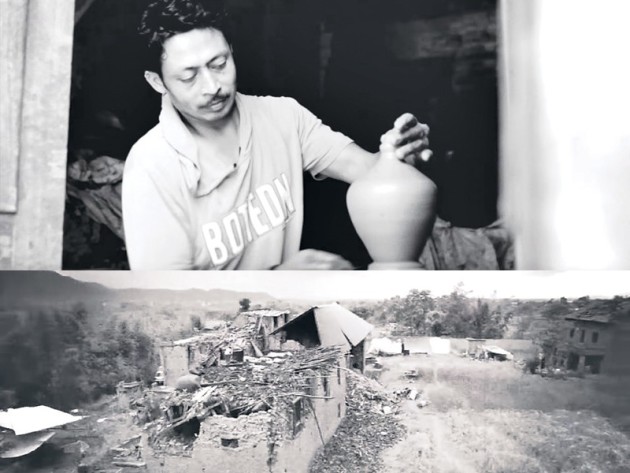Artistry over mass appeal
 March 05: Tyo Hawa is a music video made by the acoustic duo April Rush. The song and accompanying video was produced by KJC Productions, a production house associated with the Kathmandu Jazz Conservatory in Jhamshikel. The artists behind April Rush are guitarist Rajat Rai and his wife Yankey Ongmu Lepcha. Rajat, who plays guitar in the jazz band Cadenza, holds back on this track to suit the song’s acoustic feel, while Yankey carries the song with her strong vocals.
March 05: Tyo Hawa is a music video made by the acoustic duo April Rush. The song and accompanying video was produced by KJC Productions, a production house associated with the Kathmandu Jazz Conservatory in Jhamshikel. The artists behind April Rush are guitarist Rajat Rai and his wife Yankey Ongmu Lepcha. Rajat, who plays guitar in the jazz band Cadenza, holds back on this track to suit the song’s acoustic feel, while Yankey carries the song with her strong vocals.
The feel or genre of the song can be described as soft jazz, or adult contemporary evocative of artists like Norah Jones. It has a gentle feel, with well-balanced instrumentals, but at over five minutes in length, it drags on a bit too long for the average listener.
The video and the song at first glance appear to speak to two different audiences. On one hand, the lyrics of the song are about waiting for love, while the music video is packed with black and white historical footage from the last twenty years of the problems prevailing in Nepal. The video starts with someone in a cafe reading a newspaper with the headline New Constitution, an obvious nod to the current political situation in Nepal. The video then moves from clips of the couple singing and playing to a shot of an old man carrying water, perhaps a reference to the traditional Nepali culture that stretches back centuries. From there, the video moves through black and white footage that depicts the Maoist uprising, the royal family massacre, the abdication of King Gyanendra, the earthquake of 2015, and finally the signing of the new constitution. The message here is clear: In the last twenty years, Nepal has been through a lot of difficult and traumatic times. While the new constitution is presented in the video as a ‘new era’ for Nepal, it is important that people remember the long and painful road that has brought them there.
Near the end of the song, the stock footage reverses, moving through the clips of pivotal moments, returning to the shot of someone reading a newspaper, presenting the constitution of 2015 as a new era in Nepal. The slow pace of the song combined with this striking video footage creates a feeling of sadness and nostalgia without pushing any specific message onto its viewers. This in itself is a particularly powerful statement as so many of these events over the years have been interpreted and distorted through political lenses and used to serve different interests at different times. In this sense, the video is neither Maoist nor Monarchist, but simply presents the raw facts. In doing so, it acts as a reminder to the people of Nepal, regardless of their background, and delivers a powerful timeline of the key events in the nation’s recent history.
Because of its serious nature, this video is unlikely to garner the kind of attention that a typical pop video might receive, and that is at once its strength and weakness. The video is powerful because it demands more of its audience, and because it requires a basic understanding of contemporary history to appreciate it fully. Mass success of the video may be hindered as many people consume media to engage in some fantasy world, and this video is a reminder of the harsh realities in Nepal. The fact that its audience may be limited is not lost on the video’s creators.
Rajat himself acknowledged as much when I sat down to speak to him about his video. He explained, “If we wanted our video to have a million views, we would have made a typical romantic song and filmed us dancing in the hills surrounding Kathmandu. We wanted to convey something that we thought was important, and to remind people, as we move forward, to not forget about how we got here”.
This balance between connecting with an audience and diluting one’s message is an issue that all artists have to face throughout their careers. While artists want their art to be enjoyed and to be understood, not all of them are prepared to abandon their artistic integrity to have mass appeal. When artists choose only to create what they anticipate will be popular, it creates a downward spiral of culture, where artists produce sub-par material for their listeners, who in turn, never develop good taste because they are not exposed to art that may challenge them.
Choosing to make a meaningful product that will challenge its audience is always a bold move, and rarely a profitable one. In a country like Nepal, where artists constantly struggle, the pressure to create a product that is easily consumed is extremely high. Resisting that pressure and challenging the status quo is necessary for the arts to evolve, and what may be seen today as odd and inaccessible may one day become the new normal. That April Rush is pushing the discourse forward with regard to music and video production in Nepal is truly commendable. Source: The Kathmandu Post
